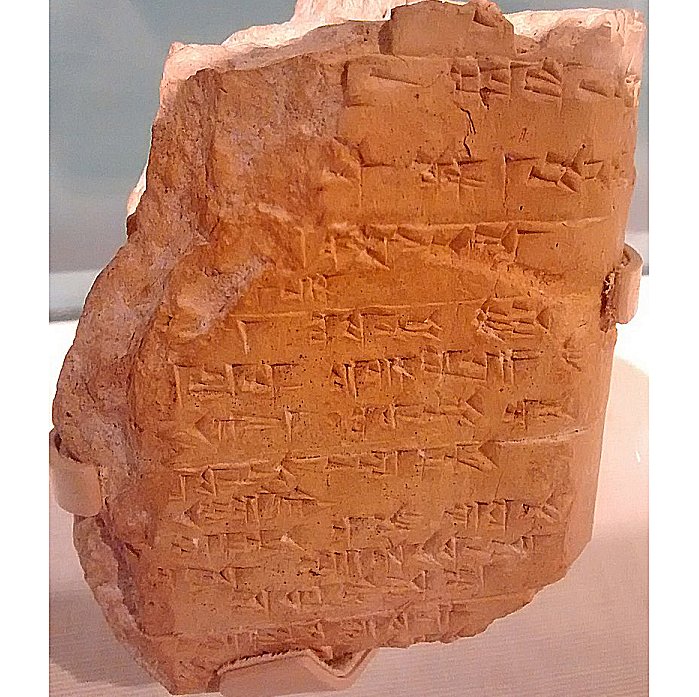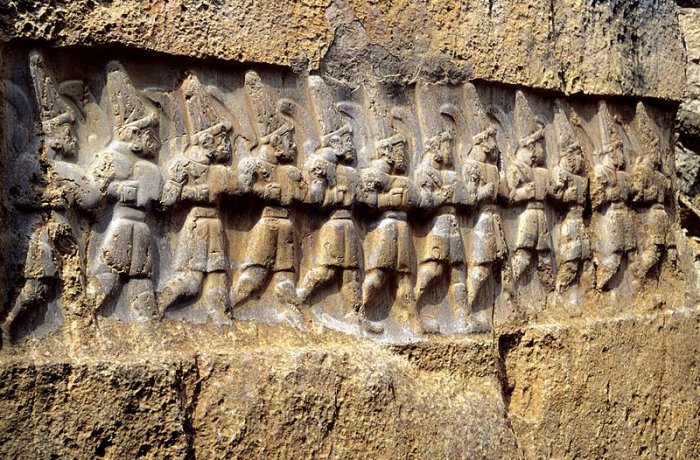The Hittites – Rise And Fall Of An Ancient Powerful Empire
Ellen Lloyd - AncientPages.com - The Hittites were once one of the most powerful ancient civilizations that occupied the ancient region of Anatolia.
Left: Neo-Hittite storm god "Tarhunzas" in the Aleppo museum. Credit: Verity Cridland, Wikipedia, CC BY 2.0 - Right: Sphinx Gate, Hattusa, Turkey. Credit: Bernard Gagnon, Wikipedia, CC BY-SA 3.0
This long-gone culture has greatly interested archaeologists and historians, but unraveling the truth about the Hittites has been difficult.
The Mysterious Language Of The Hittites
Although the civilization was over 4,000 years old, it was first in 1834 that a French scholar discovered ancient ruins that could be linked to the Hittites. Most ancient documents describing this culture, once a rivaling threat to the ancient Egyptian kingdom, were lost in the sand.
Most of the Hittites were illiterate and could not describe their daily lives. However, ancient clay tablets have shed more information on the Hittites. However, one of the problems scientists face when they attempt to decode the script is that many different languages dominated Anatolia during this historical period. The Hittites borrowed words and phrases from other languages, making it difficult for modern scholars to determine this ancient civilization's original roots.
Scientists now say that the mysterious language of the Hittites reveals the history of this ancient civilization is much more complex than previously thought.
 Egyptian pharaoh Ramesses II stormed the Hittite fortress of Dapur. Image credit: Nordisk familjebok - Public Domain
Egyptian pharaoh Ramesses II stormed the Hittite fortress of Dapur. Image credit: Nordisk familjebok - Public Domain
Based on what is known, the Hittites were mentioned in the Bible as a mythical kingdom. Still, archaeologists have provided sufficient evidence that this was once a genuine culture buried over time.
Ancient records discovered in Egypt tell of a kingdom called Kheta. Historians connected Kheta with the Biblical Hittites.
Still, very little was known about this mysterious ancient Anatolian civilization. This changed in 1906 when German archaeologist Hugo Winckler discovered a royal archive with over 10,000 clay tablets inscribed in cuneiform by people using an unknown language. These ancient tablets were the same as those found at Tell el-Amarna in Egypt and on the inscriptions on the monuments found in Turkey.
Czech linguist Derdich Hrozny decoded the script in 1915 and published the results of his study in his book The Language of the Hittites; Its Structure and Its Membership in the Indo-European Linguistic Family. In his book, Hrozny explained that the mysterious language of the Hittites is not Middle Eastern but rather an "Indo-European language.
This discovery opens an intriguing chapter in the history of the Hittites and has led to speculation about where the civilization came from. Could these people have originated from Central Europe? Why were they using an Indo-European language? Some scholars think the Hittites originated from the area beyond the Black Sea.
The Rise And Downfall Of The Hittite Empire
The Hittites entered Anatolia around 2000 B.C., and their capital would eventually be Hattusha in what is today modern Turkey. It took them about 400 years before they developed. The empire's first ruler was Hattusili, which meant "the one from Hattusha."
Once they had organized their society, they started conquering native peoples, such as Hurrians and Hattians. They spread their culture and language throughout the region. Knowledge about their activities has been documented on cuneiform tablets, one of the earliest systems of writing invented by the Sumerians.
A Hittite tablet found at Hattusa is believed to be a legal deposition. Image credit: Mx. Granger - CC0
As Captivating History writes in the book Hittites: A Captivating Guide to the Ancient Anatolian People Who Established the Hittite Empire in Ancient Mesopotamia, "Eventually the Hittites would adopt a cuneiform script from the remnants of Assyrian settlements which stayed after the fall of the larger Assyrian Empire."
These ancient cuneiform tablets taught us about the professions, work, religion, and various aspects of their daily life.
The Hittites were a totalitarian regime with the kings ruling with absolute power. All family activities were monitored and controlled. There was no private ownership because the community-owned all property.
Like many other great ancient civilizations, the Hittites had laws that regulated various aspects of their vast empire. Written between 1650 and 1500 BC, the Code of Nesilim was a document that stated the ancient laws of the Hittites. One of its most significant topics is the treatment of enslaved people. The Code of Nesilim reveals much about the social structure of society. Compared to the Code of Hammurabi, where death was the punishment for most offenses described, the punishments in the Code of Nesilim were not very severe.
Most of the Hittites were farmers and laborers. Still, there were also powerful landlords, who, according to Captivating History, "supplied the monarchy with much of its power by pledging military service, soldiers, and weapons in land exchange and occasionally money. Without trust, understanding, and loyalty between the nobility and the king, the kingdom would have fallen apart from a lack of cohesion."
As they expanded their territories, they seriously threatened our powerful ancient civilizations. Between the 15th and 13th centuries B.C., the Hittite Empire came into conflict with the Egyptian Empire, the Middle Assyrian Empire, and the Mitanni kingdom for control of the Near East. The early Hittite king Mursili[s] I conquered Babylon about 1595 B.C. (some historians suggest it could be as late as 1506 B.C or as early as 1651 B.C)
Twelve Hittite gods of the underworld in the nearby Yazilikaya, a sanctuary of Hattusha. Credit: Klaus-Peter Simon, Wikipedia, CC BY 3.0
To prosper, the Hittites had to take control of the trade routes and metal sources. However, the Egyptians needed to allow the Hittite Empire to gain more strategic ground.
This is one of the reasons that led to the Battle of Kadesh, a clash between the forces of the New Kingdom of Egypt under Ramesses II and the Hittite Empire under Muwatalli II in 1274 B.C.
Historians say it is the best-documented battle in all of ancient history. It was also the largest chariot battle ever fought, involving 5,000 and 6,000 chariots. After having expelled the Hyksos people around 1550 B.C., Egyptian rulers became more aggressive. The Amarna letters reveal that Egypt was losing influence in the region.
When pharaoh Ramesses II advanced with his troops on the Hittite-held city of Kadesh, two of the most potent and massive forces engaged each other, and the result was a blow to both states. Because of the significant losses to the Hittites, the Egyptians won this battle, but it was a Pyrrhic victory. Nevertheless, the Battle of Kadesh is essential because it led to the world's first recorded peace treaty.
An ancient text that survived reads: "Reamasesa-Mai-Amana, the great king, the king of the country of Egypt, shall never attack the country of Hatti to take possession of a part (of this country). And Hattusili, the great king of the country of Hatti, shall never attack the country of Egypt to take possession of a part (of that country). "
The fall of the Hittite Empire came suddenly around 1193 B.C. When Assyrians became the most dominant power in the region, the Hittites lost much of their importance. The Assyrians much of the Hittite Empire, while the Phrygians sacked the rest. This forced the Hittites to split into several independent "Neo-Hittite" city-states, some of which survived until the 8th century B.C. before succumbing to the Neo-Assyrian Empire.
The Hittite Empire is long gone, but its legacy remains. Their ancient ruins found at sites such as Yazilikaya and Hattusha testify to the greatness of this once-powerful civilization. Also, remember that the earliest depiction of the significant double-headed eagle symbol can be found on ancient monuments in central Anatolia in the ancient Kingdom of the Hittites.
Updated on August 19, 2024
Written by Ellen Lloyd – AncientPages.com
Copyright © AncientPages.com All rights reserved. This material may not be published, broadcast, rewritten or redistributed in whole or part without the express written permission of AncientPages.com
Expand for referencesMore From Ancient Pages
-
 Rare Roman Mosaic Depicting The Adventures Of Greek Hero Achilles Discovered In Rutland, UK
Archaeology | Dec 4, 2021
Rare Roman Mosaic Depicting The Adventures Of Greek Hero Achilles Discovered In Rutland, UK
Archaeology | Dec 4, 2021 -
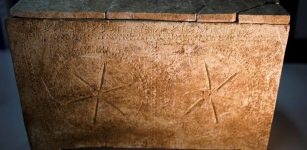 ‘Ali Baba Cave’ Treasures: Burial Boxes Inscribed With Jesus’ Name May Help Reconstruct Jesus’ Life And Death
Archaeology | Mar 21, 2017
‘Ali Baba Cave’ Treasures: Burial Boxes Inscribed With Jesus’ Name May Help Reconstruct Jesus’ Life And Death
Archaeology | Mar 21, 2017 -
 Mystery Of Hizir – One Of The Most Enigmatic And Extraordinary Ancient People
Featured Stories | Oct 16, 2018
Mystery Of Hizir – One Of The Most Enigmatic And Extraordinary Ancient People
Featured Stories | Oct 16, 2018 -
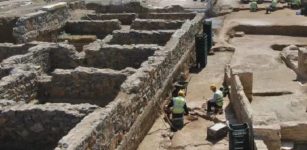 Tile Tomb Dated To The Late Hellenistic Era – Discovered In Surroundings Of Istanbul, Turkey
Archaeology | Jun 6, 2022
Tile Tomb Dated To The Late Hellenistic Era – Discovered In Surroundings Of Istanbul, Turkey
Archaeology | Jun 6, 2022 -
 Newport Ship: Experts Reassemble Medieval Vessel Found In The Mud
Featured Stories | Feb 7, 2023
Newport Ship: Experts Reassemble Medieval Vessel Found In The Mud
Featured Stories | Feb 7, 2023 -
 Incredible Prehistoric Discoveries Made By A Local Community That Helped Researchers
Featured Stories | Mar 23, 2023
Incredible Prehistoric Discoveries Made By A Local Community That Helped Researchers
Featured Stories | Mar 23, 2023 -
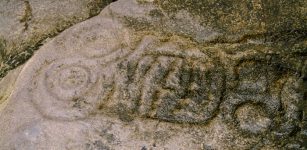 Prehistoric Temperatures Of North America’s Oldest Archaeological Sites Shed New Light On Ancient Human Migration
Archaeology | Apr 3, 2023
Prehistoric Temperatures Of North America’s Oldest Archaeological Sites Shed New Light On Ancient Human Migration
Archaeology | Apr 3, 2023 -
 Exceptionally Long-Lived Ancient Form Of Hydraulic Engineering Unearthed In The Nile Valley
Archaeology | Jun 13, 2023
Exceptionally Long-Lived Ancient Form Of Hydraulic Engineering Unearthed In The Nile Valley
Archaeology | Jun 13, 2023 -
 Unknown Fragments Of Two Euripides Tragedies Found In Egyptian Grave
Scripts, Paintings & Inscriptions | Sep 9, 2024
Unknown Fragments Of Two Euripides Tragedies Found In Egyptian Grave
Scripts, Paintings & Inscriptions | Sep 9, 2024 -
 3,000-Year-Old Egyptian Artificial Wooden Toe In New Light
Archaeology | Jun 20, 2017
3,000-Year-Old Egyptian Artificial Wooden Toe In New Light
Archaeology | Jun 20, 2017 -
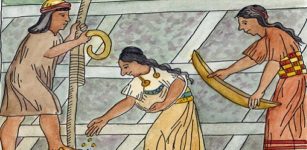 Why Was Ayllu Very Important For The Inca People?
Ancient History Facts | Feb 19, 2019
Why Was Ayllu Very Important For The Inca People?
Ancient History Facts | Feb 19, 2019 -
 Never-Before-Seen Structures Of King Herod’s Magnificent Palace Herodium Unveiled
Archaeology | Dec 11, 2020
Never-Before-Seen Structures Of King Herod’s Magnificent Palace Herodium Unveiled
Archaeology | Dec 11, 2020 -
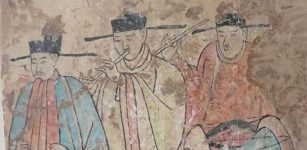 Ancient Fresco Tomb Dated A 1000-Years Ago Was Accidentally Discovered In Northern China
Archaeology | May 5, 2020
Ancient Fresco Tomb Dated A 1000-Years Ago Was Accidentally Discovered In Northern China
Archaeology | May 5, 2020 -
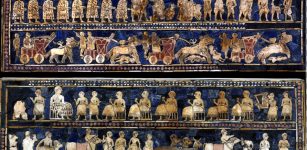 Image Of The Day: ‘The Standard of Ur – War And Peace’
Civilizations | Sep 7, 2015
Image Of The Day: ‘The Standard of Ur – War And Peace’
Civilizations | Sep 7, 2015 -
 Mystery Of The Lost Biblical Kadesh Where Moses Was Punished By God
Biblical Mysteries | Oct 17, 2017
Mystery Of The Lost Biblical Kadesh Where Moses Was Punished By God
Biblical Mysteries | Oct 17, 2017 -
 Controversial Story And Secret Knowledge Of Li Ching-Yuen Who Lived For 256 Years
Featured Stories | Sep 19, 2015
Controversial Story And Secret Knowledge Of Li Ching-Yuen Who Lived For 256 Years
Featured Stories | Sep 19, 2015 -
 The Aztec Sun Stone And Medusa Reveal An Intriguing Connection – A Different Gorgon And Strange Location – Part 2
Civilizations | Aug 1, 2018
The Aztec Sun Stone And Medusa Reveal An Intriguing Connection – A Different Gorgon And Strange Location – Part 2
Civilizations | Aug 1, 2018 -
 El Mirador: Ancient Pyramids Hidden In The Lost City Of The Maya
Featured Stories | Aug 1, 2018
El Mirador: Ancient Pyramids Hidden In The Lost City Of The Maya
Featured Stories | Aug 1, 2018 -
 On This Day In History: Execution Of Saints Crispin And Crispinian – On Oct 25, 286
News | Oct 25, 2016
On This Day In History: Execution Of Saints Crispin And Crispinian – On Oct 25, 286
News | Oct 25, 2016 -
 Mysterious Biblical Celestial City And Its Connection To The North Star – Nonhuman Hands – Part 1
Biblical Mysteries | Feb 22, 2021
Mysterious Biblical Celestial City And Its Connection To The North Star – Nonhuman Hands – Part 1
Biblical Mysteries | Feb 22, 2021


